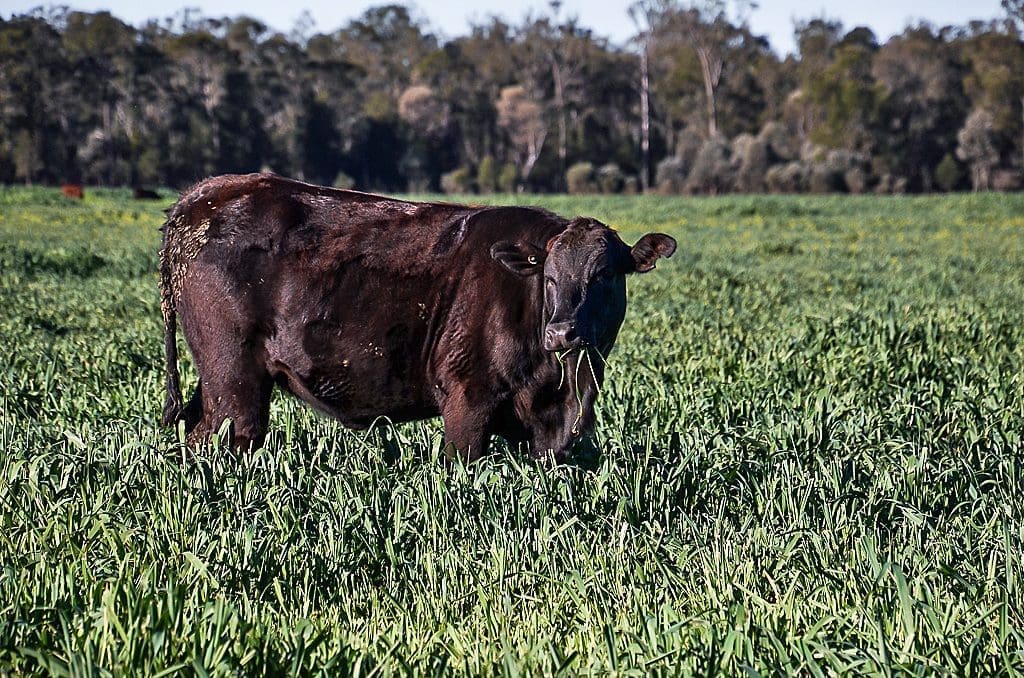
Cattle grazing oats on Brigalow-Belah country near Dulacca cleared 20 years ago. 280 hectares of the 1400 hectare property, or 20 percent, is zoned never to be cleared.
The Queensland Government’s blaming of agricultural practices for Great Barrier Reef damage while ignoring the impact of coal mine water releases it authorised in the same catchments demonstrates the hypocrisy of its policies, the head of a landholder group, the Basin Sustainability Alliance, says.
BSA chairman Lee McNicholl, a cattle producer from Dulacca, said Queensland Environment and Heritage Minister Dr Steven Miles was blaming variable damage along the Great Barrier Reed on agricultural run-off in coastal catchments at any opportunity and unjustifiably.
However, he said, the Minister had failed to mention the impact of 209 “authorised releases” of coal mine water in coastal catchments since November 2013.
Mr McNicholl said gigalitres of tailings dam water from 42 coal mines had been poured into steams across the Fitzroy catchment as a result of the releases.
He urged Dr Miles to consider the findings of a recent Griffith University research paper showing land use and water quality trends in the Fitzroy River from 1964 to 2008.
The Fitzroy Basin was analysed because it is one of the largest sources of freshwater and sediment for the Great Barrier Reef Lagoon.
“The Basin was largely undisturbed before 1960,” Mr McNicholl said.
“Currently 90 percent has been cleared for grazing, cropping and sown pasture.
“Their findings are ‘there are no significant trends in mean annual sediment concentration nor in the sediment discharge into the GBR Lagoon’”.
“If Dr Miles had any genuine scientific credibility he would be congratulating farmers for achieving such a great sustainability outcome instead of relentlessly demonizing us.
“Further, if he was serious about climate change induced Great Barrier Reef damage he would be shutting down coal mines rather than turning a blind eye to their unsustainable activities.”
21 species threatened by land clearing: Qld Govt
Last weekend Dr Miles announced a review into the risks posed to Queensland’s plant and animal species from tree-clearing.
The announcement came after Queensland’s Species Technical Committee (STC) said 21 of 29 species of flora and fauna it reviewed were threatened by tree clearing.
Of those nine had been to “endangered”, Dr Miles said.
“Action needs to be taken before more of Queensland’s world-famous plants and animals are wiped out,” Dr Miles said.
“This is a long term trend in Queensland, with an increasing number of our native plants and animals being put more and more at risk of slipping toward extinction.
“The threats include habitat destruction from clearing, predation and competition by introduced species, introduced diseases and climate change.
“Today I’m announcing I have written to the Species Technical Committee requesting an impartial, scientifically sound report on the role of land clearing in the decline of native wildlife,” he said.
The STC’s membership includes scientific experts from universities, the Department of Environment and Heritage Protection; Department of Science, Information Technology, Innovation and the Arts, and the Commonwealth.
The committee recommended the Bramble Cay melomys, a mouse-like rodent that lived on a small grass-covered cay (a low-lying island in a coral reef) in Australia’s Great Barrier Reef, be upgraded from Endangered to Extinct in the Wild.
It also recommended 10 species of fauna be upgraded from Least Concern to Vulnerable; three species of fauna from Vulnerable to Endangered; five species of fauna from Least Concern to Endangered; one species of bird from Near Threatened to Endangered; and one species of bird from Near Threatened to Vulnerable.
The species included the wedge-tailed shearwater (up-listed from Least Concern to Vulnerable with climate change impacts being a key factor in its decline); the hawksbill turtle (Vulnerable to Endangered); Fassifern blind snake (Least Concern to Vulnerable); yellow-footed rock-wallaby (Least Concern to Vulnerable); the palm cockatoo (Near Threatened to Vulnerable), and the greater glider (Least Concern to Vulnerable).
Dr Miles said scientists believed the greater glider had moved to a more severe category as a result of a range of threats, including tree-clearing.
“The greater glider feeds almost exclusively on eucalyptus leaves and buds, and lives in trees, so the destruction of its habitat and food source is sure to be detrimental to its survival, he said.
“What makes the committee’s latest findings even more disturbing, is that they come just days after the Palaszczuk Government released new data confirming tree clearing is continuing at unacceptably high levels in Queensland.
“The latest SLATS report reveals almost 300,000 hectares per year have been cleared since the reckless LNP trashed Labor’s responsible tree clearing laws in 2013.
“That is why we want to introduce effective and balanced land clearing laws that will protect the environment, and our unique flora and fauna,’’ he said.
Source: Basin Sustainability Alliance, Queensland Government

It is a few good points; excellently made, Mr Lee McNicol!
It is noteworthy that the good Dr. Miles had to enunciate ” … an impartial, scientifically sound report …”.
What is the alternative?
If a report is requested by Government, I would have thought those adjectives uneccessary ; as a expected tautology …
There are already so many impartial, scientifically prepared reports that show the Graziers are doing the right thing as good economic Stewards!
What is wrong with these people!!
There is a rhetorical question in there somewhere …
If the Scientists at the Universities were not so ‘gagged’, an honest debate may likely emerge!